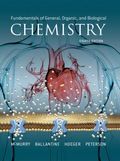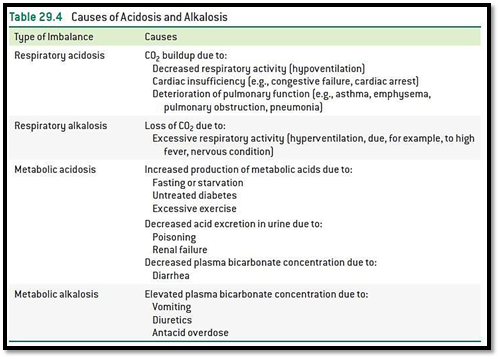
(a)
Interpretation:
The given condition should be classified whether as a cause of respiratory or metabolic acidosis or alkalosis using the table 29.4.
Concept introduction:
The highly specific acid-base quality of various body fluid remains regulated within narrow limits because of high sensitivity of
Alkalosis is a term which refers to an increase in pH above the normal average of
Acidosis is a term which refers to an increase in

Figure 1
(b)
Interpretation:
The given condition should be classified whether as a cause of respiratory or metabolic acidosis or alkalosis using the table 29.4.
Concept introduction:
The highly specific acid-base quality of various body fluid remains regulated within narrow limits because of high sensitivity of metabolism to the
Alkalosis is a term which refers to an increase in pH above the normal average of
Acidosis is a term which refers to an increase in

Figure 1
(c)
Interpretation:
The given condition should be classified whether as a cause of respiratory or metabolic acidosis or alkalosis using the table 29.4.
Concept introduction:
The highly specific acid-base quality of various body fluid remains regulated within narrow limits because of high sensitivity of metabolism to the
Alkalosis is a term which refers to an increase in pH above the normal average of
Acidosis is a term which refers to an increase in

Figure 1
Want to see the full answer?
Check out a sample textbook solution
Chapter 29 Solutions
EBK FUNDAMENTALS OF GENERAL, ORGANIC, A
- A 19 year old college student has been vomiting all night and has a tingling sensation in her face. Her ABG results are as follows: pH - 7.49 pCO2-46.5 HCO3 - 27.5 1. Is she in acidosis or alkalosis? 2. Is the cause respiratory or metabolic? 3. Is this uncompensated, partially compensated or fully compensated?arrow_forwardAdult male suffered myocardial infarction and is currently in cardiogenic shock. Blood pH = 7.25, [HCO3-] = 14 mmol/L, PaCO2 = 38 mmHg. What kind of acid-base imbalance is the patient suffering from? Briefly describe fully how this occurred.arrow_forwarda 86 years old women brought to emergency room with these readings :PH = 7.22 (normal :7.35-7.45) , PaCO2 = 9.6 mmHg ( normal: 35-45) ,HCO3- = 3.9 mmol/l ( normal : 22-26) .. she complains from : A) Metabolic acidosis. B)Respiratory acidosis. C)Metabolic alkalosis. D)Respiratory alkalosis.arrow_forward
- 70. A 68-year-oldman with chronic respiratoryacidosis has an arterial pHof 7.34 and an arterial PCO2 of 55 mm Hg. Which of the following best explains the compensatory response to the acidosis? A) Decreased HCI secretion by the stomach B) Decreased tubular secretion of HCO," by the kidneys C) Increased CO2 excretion by the lungs O D) Increased HCO3" reabsorption by the kidneys E) IncreasedHCO,"transport by the choroid plexusarrow_forwardA student got so excited about her acceptance into dental school that she began hyperventilating and then passed out. How might passing out, for a short time, be advantageous? What is her primary acid-base disorder?arrow_forwardIndividuals with cystic fibrosis produce thick mucus in the lungs, resulting in a higher-than-normal level of CO2 in the blood. What is the problem that results from higher-than-normal levels of COz in the blood? Please relate this to buffers in the blood and construct a clear problem statement.arrow_forward
- What do the following arterial blood values indicate? pH = 7.59 PCO2 = 45 mm Hg HCO3- = 35 mEq/L Question 47 options: Respiratory acidosis without compensation Metabolic alkalosis without compensation Respiratory alkalosis without compensation Respiratory acidosis with partial compensation Mixed disturbancearrow_forwardHenry is in the intensive care unit because he suffered a severe myocardial infarction three days ago. The lab reports the followingvalues from an arterial blood sample: pH 7.30, HCO320 mEq/ liter, PCO2 32 mmHg. Diagnose Henry’s acid–base status and decide whether compensation is occurring.arrow_forward1) Identify the lab value of Yusef's bicarbonate ion level in mEq/Liters. Only type in numbers, no letters (type out your number to zero places after the decimal point. i.e 8 or 18) pH = 7.68 PaCO2 = 21 mmHg 2) His condition is : 3 answers required: respiratory or metabolic acidosis or alkalosis uncompensated or partial compensation Group of answer choices respiratory metabolic acidosis alkalosis uncompensated partial compensationarrow_forward
- A patient exhibits the following blood characteristics. pH = 7.49 P co2 = 50 HCO3- = 29 mEq/L What is the likely condition? respiratory acidosis respiratory alkalosis metabolic acidosis metabolic alkalosisarrow_forwardMetabolic acidosis is often treated by administering hydrogen carbonate intravenously. Explain how this treatment can increase blood plasma pH.arrow_forwardA 79 year old man with COPD has been admitted to the hospital. His ABG results are as follows: pH - 7.35 pCO2 - 46.5 HCO3--27.5 1. Is he in acidosis or alkalosis? 2. Is the cause respiratory or metabolic? 3. Is this uncompensated, partially compensated or fully compensated?arrow_forward
 Human Physiology: From Cells to Systems (MindTap ...BiologyISBN:9781285866932Author:Lauralee SherwoodPublisher:Cengage Learning
Human Physiology: From Cells to Systems (MindTap ...BiologyISBN:9781285866932Author:Lauralee SherwoodPublisher:Cengage Learning

